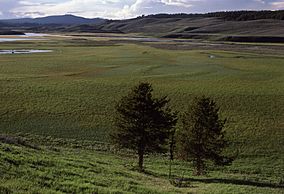Hayden Valley facts for kids
Hayden Valley is a big, beautiful valley in Yellowstone National Park in Wyoming. It sits right along the Yellowstone River, between the famous Yellowstone Falls and Yellowstone Lake. Long ago, this valley was actually part of a much larger Yellowstone Lake! Today, Hayden Valley is known as one of the best places in Yellowstone to see amazing wildlife.
Quick facts for kids Hayden Valley |
|
|---|---|

Hayden Valley, 1977
|
|
| Location | Yellowstone National Park, Wyoming |
| Named for | Named for Ferdinand V. Hayden |
Contents
History of Hayden Valley
Hayden Valley was a natural pathway to Yellowstone Lake for early trappers, explorers, and Native Americans. They would travel along the Yellowstone River. On August 29, 1870, two explorers named Henry D. Washburn and Gustavus Cheyney Doane climbed Mount Washburn. From there, they saw the huge Hayden Valley stretching out between Yellowstone Falls and the lake.
Early Descriptions of the Valley
Gustavus Doane wrote in his journal about what he saw from Mount Washburn. He described a wide, grassy valley with a small stream. This stream flowed into the Yellowstone River, which then disappeared into the Grand Canyon. Doane also noted the large Yellowstone Lake to the south.
Who Named Hayden Valley?
The valley is named after Ferdinand Vandeveer Hayden. He was a geologist who explored the Yellowstone area. His 1871 survey helped lead to the creation of Yellowstone National Park.
It's not completely clear who first named the valley. Some people think it was the Earl of Dunraven during his visit in 1872. However, the name first appeared on maps in 1880. This was in a report from the park superintendent, Philetus Norris.
Calls for a New Name
In 2018, some Native American leaders suggested renaming the valley "Buffalo Nation's Valley." They explained that Ferdinand Hayden had supported actions against tribal people who did not follow government rules. Because of this, they believe the valley should have a different name.
Where is Hayden Valley Located?
Hayden Valley is right in the middle of Yellowstone National Park. It is about 7 miles (11 km) long from north to south and 7 miles (11 km) wide from east to west. This means it covers about 50 square miles (130 km²) of the park.
Most of the valley is west of the Yellowstone River, between the Canyon area and Yellowstone Lake. The Grand Loop Road, which is a main road in the park, runs along the eastern side of the valley, close to the river.
Geothermal Features in the Valley
Hayden Valley has several interesting geothermal features. These are places where heat from deep inside the Earth comes to the surface. While they might not be as big as the famous geysers in other parts of Yellowstone, they were some of the first features discovered by early explorers.
Some of these features include:
- Mud Volcano
- Mud Geyser
- Sulphur Caldron
- Black Dragon Caldron
These are all found at the southern end of the valley. Further north and west of the river, you can find Sulphur Spring in the Crater Hills group.
Important Wildlife Habitat
Hayden Valley is a very important home for many animals. It's a great place to see buffalo, elk, grizzly bears, coyotes, and wolves. You can also spot many smaller mammals and different kinds of birds here.
To protect this special habitat and the animals, visitors are not allowed to walk off the trails in the valley. There are two main trails that hikers can use:
- The Hayden Valley trail runs next to the river on the eastern side, from Lake to Canyon.
- The Mary Mountain trail goes along the northern edge of the valley, following Alum Creek.
Also, all the rivers, creeks, and ponds in Hayden Valley are closed to fishing. This helps keep the natural environment safe for the wildlife.
- Images of Hayden Valley
-
Hayden Valley, F. Jay Haynes photo, 1909





